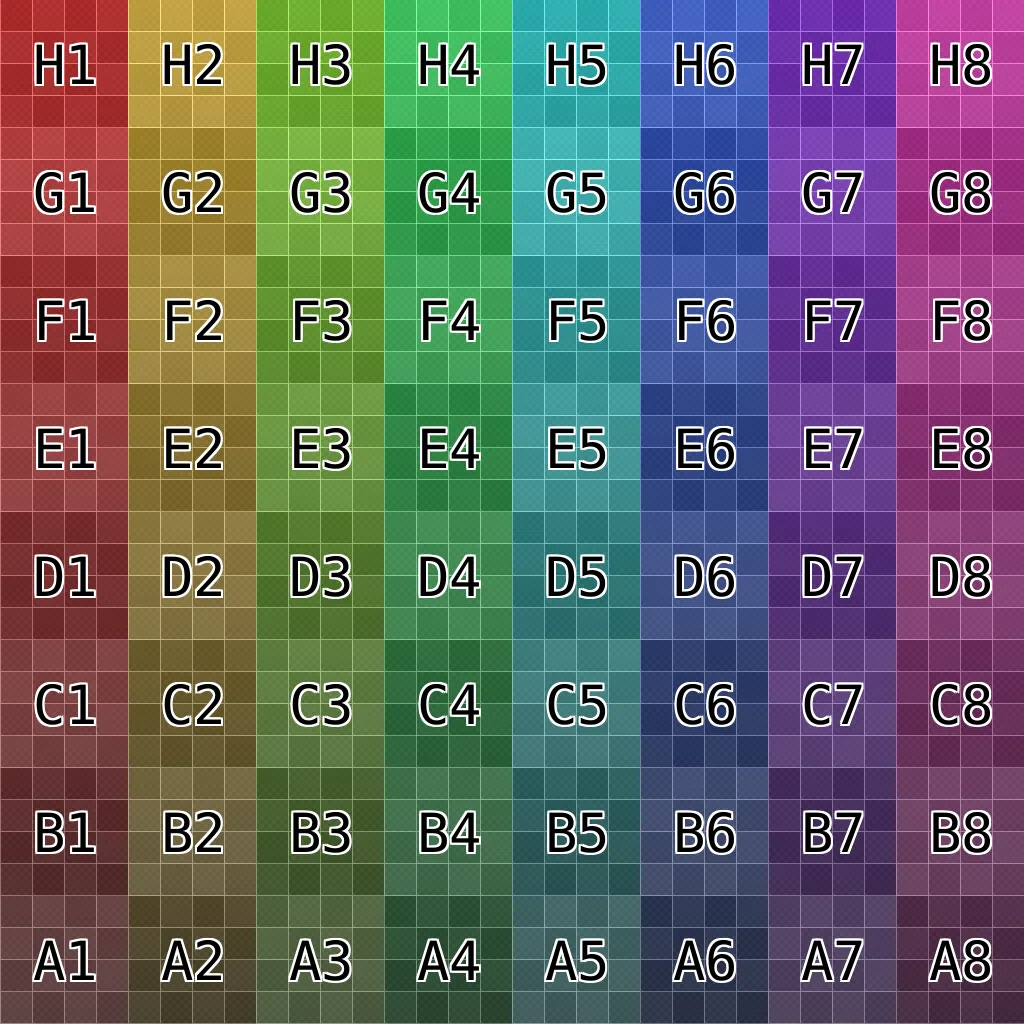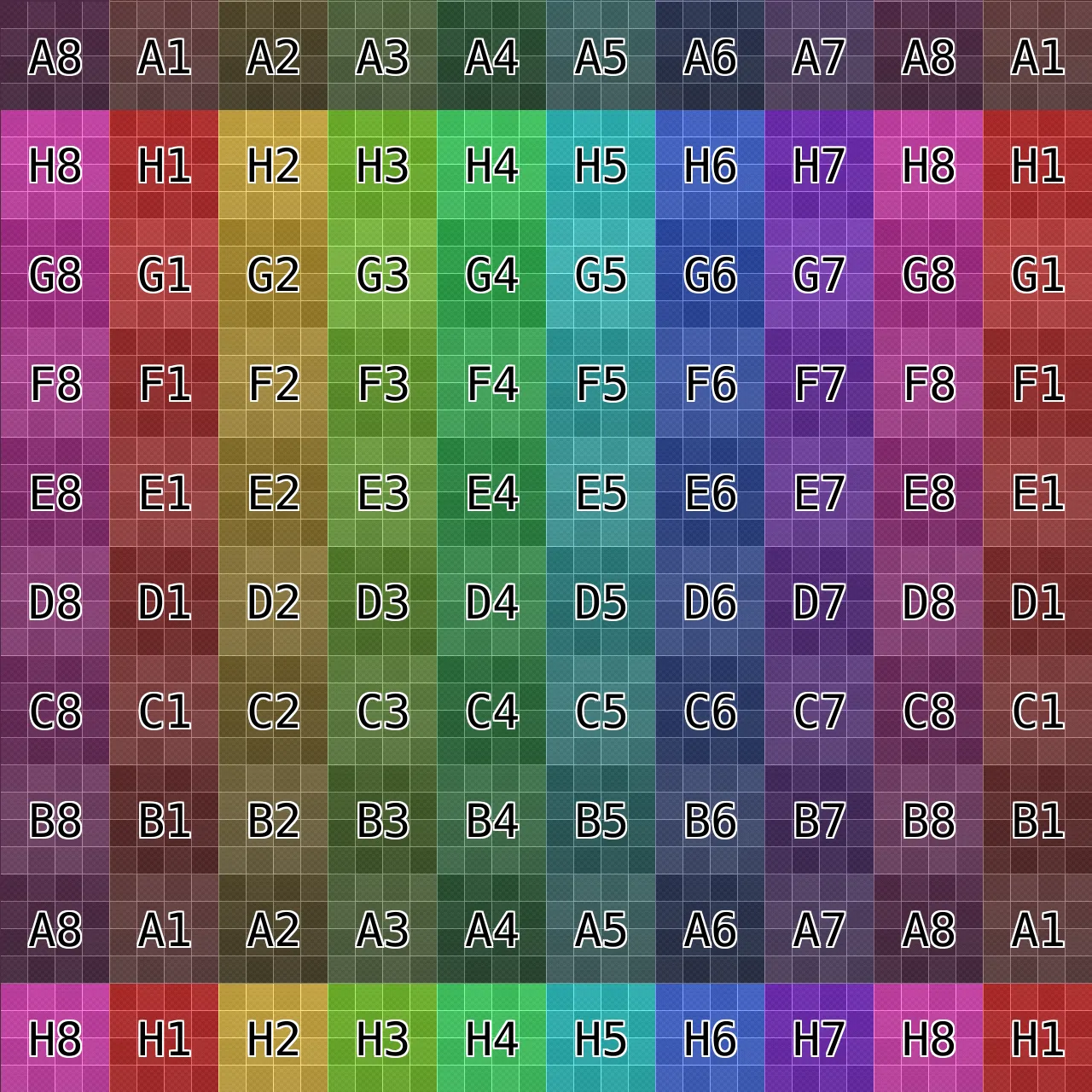我需要获取模型和相机之间的旋转差异,并将值转换为弧度/角度,然后传递给片段着色器。
为此,我需要分解模型旋转矩阵,可能还需要相机视图矩阵。我似乎找不到一个适合在着色器内部进行分解的机制。
旋转细节进入片段着色器以计算UV偏移量。
original_rotation + viewing_angles 用于计算以下纹理的精灵偏移,作为广告牌显示。
最终,UV应该向下偏移(例如:从H3到A3,从上向下看),向上偏移(例如:从A3到H3,从上向下看),从左到右看,从侧面向前看(例如:从D1到D8,反之亦然)。
为此,我需要分解模型旋转矩阵,可能还需要相机视图矩阵。我似乎找不到一个适合在着色器内部进行分解的机制。
旋转细节进入片段着色器以计算UV偏移量。
original_rotation + viewing_angles 用于计算以下纹理的精灵偏移,作为广告牌显示。
最终,UV应该向下偏移(例如:从H3到A3,从上向下看),向上偏移(例如:从A3到H3,从上向下看),从左到右看,从侧面向前看(例如:从D1到D8,反之亦然)。
const vertex_shader = `
precision highp float;
uniform mat4 modelViewMatrix;
uniform mat4 projectionMatrix;
attribute vec3 position;
attribute vec2 uv;
attribute mat4 instanceMatrix;
attribute float index;
attribute float texture_index;
uniform vec2 rows_cols;
uniform vec3 camera_location;
varying float vTexIndex;
varying vec2 vUv;
varying vec4 transformed_normal;
float normal_to_orbit(vec3 rotation_vector, vec3 view_vector){
rotation_vector = normalize(rotation_vector);
view_vector = normalize(view_vector);
vec3 x_direction = vec3(1.0,0,0);
vec3 y_direction = vec3(0,1.0,0);
vec3 z_direction = vec3(0,0,1.0);
float rotation_x_length = dot(rotation_vector, x_direction);
float rotation_y_length = dot(rotation_vector, y_direction);
float rotation_z_length = dot(rotation_vector, z_direction);
float view_x_length = dot(view_vector, x_direction);
float view_y_length = dot(view_vector, y_direction);
float view_z_length = dot(view_vector, z_direction);
//TOP
float top_rotation = degrees(atan(rotation_x_length, rotation_z_length));
float top_view = degrees(atan(view_x_length, view_z_length));
float top_final = top_view-top_rotation;
float top_idx = floor(top_final/(360.0/rows_cols.x));
//FRONT
float front_rotation = degrees(atan(rotation_x_length, rotation_z_length));
float front_view = degrees(atan(view_x_length, view_z_length));
float front_final = front_view-front_rotation;
float front_idx = floor(front_final/(360.0/rows_cols.y));
return abs((front_idx*rows_cols.x)+top_idx);
}
vec3 extractEulerAngleXYZ(mat4 mat) {
vec3 rotangles = vec3(0,0,0);
rotangles.x = atan(mat[2].z, -mat[1].z);
float cosYangle = sqrt(pow(mat[0].x, 2.0) + pow(mat[0].y, 2.0));
rotangles.y = atan(cosYangle, mat[0].z);
float sinXangle = sin(rotangles.x);
float cosXangle = cos(rotangles.x);
rotangles.z = atan(cosXangle * mat[1].y + sinXangle * mat[2].y, cosXangle * mat[1].x + sinXangle * mat[2].x);
return rotangles;
}
float view_index(vec3 position, mat4 mv_matrix, mat4 rot_matrix){
vec4 posInView = mv_matrix * vec4(0.0, 0.0, 0.0, 1.0);
// posInView /= posInView[3];
vec3 VinView = normalize(-posInView.xyz); // (0, 0, 0) - posInView
// vec4 NinView = normalize(rot_matrix * vec4(0.0, 0.0, 1.0, 1.0));
// float NdotV = dot(NinView, VinView);
vec4 view_normal = rot_matrix * vec4(VinView.xyz, 1.0);
float view_x_length = dot(view_normal.xyz, vec3(1.0,0,0));
float view_y_length = dot(view_normal.xyz, vec3(0,1.0,0));
float view_z_length = dot(view_normal.xyz, vec3(0,0,1.0));
// float radians = atan(-view_x_length, -view_z_length);
float radians = atan(view_x_length, view_z_length);
// float angle = radians/PI*180.0 + 180.0;
float angle = degrees(radians);
if (radians < 0.0) { angle += 360.0; }
if (0.0<=angle && angle<=360.0){
return floor(angle/(360.0/rows_cols.x));
}
return 0.0;
}
void main(){
vec4 original_normal = vec4(0.0, 0.0, 1.0, 1.0);
// transformed_normal = modelViewMatrix * instanceMatrix * original_normal;
vec3 rotangles = extractEulerAngleXYZ(modelViewMatrix * instanceMatrix);
// transformed_normal = vec4(rotangles.xyz, 1.0);
transformed_normal = vec4(camera_location.xyz, 1.0);
vec4 v = (modelViewMatrix* instanceMatrix* vec4(0.0, 0.0, 0.0, 1.0)) + vec4(position.x, position.y, 0.0, 0.0) * vec4(1.0, 1.0, 1.0, 1.0);
vec4 model_center = (modelViewMatrix* instanceMatrix* vec4(0.0, 0.0, 0.0, 1.0));
vec4 model_normal = (modelViewMatrix* instanceMatrix* vec4(0.0, 0.0, 1.0, 1.0));
vec4 cam_loc = vec4(camera_location.xyz, 1.0);
vec4 view_vector = normalize((cam_loc-model_center));
//float findex = normal_to_orbit(model_normal.xyz, view_vector.xyz);
float findex = view_index(position, base_matrix, combined_rot);
vTexIndex = texture_index;
vUv = vec2(mod(findex,rows_cols.x)/rows_cols.x, floor(findex/rows_cols.x)/rows_cols.y) + (uv / rows_cols);
//vUv = vec2(mod(index,rows_cols.x)/rows_cols.x, floor(index/rows_cols.x)/rows_cols.y) + (uv / rows_cols);
gl_Position = projectionMatrix * v;
// gl_Position = projectionMatrix * modelViewMatrix * instanceMatrix * vec4(position, 1.0);
}
`
const fragment_shader = (texture_count) => {
var fragShader = `
precision highp float;
uniform sampler2D textures[${texture_count}];
varying float vTexIndex;
varying vec2 vUv;
varying vec4 transformed_normal;
void main() {
vec4 finalColor;
`;
for (var i = 0; i < texture_count; i++) {
if (i == 0) {
fragShader += `if (vTexIndex < ${i}.5) {
finalColor = texture2D(textures[${i}], vUv);
}
`
} else {
fragShader += `else if (vTexIndex < ${i}.5) {
finalColor = texture2D(textures[${i}], vUv);
}
`
}
}
//fragShader += `gl_FragColor = finalColor * transformed_normal; }`;
fragShader += `gl_FragColor = finalColor; }`;
// fragShader += `gl_FragColor = startColor * finalColor; }`;
// int index = int(v_TexIndex+0.5); //https://stackoverflow.com/questions/60896915/texture-slot-not-getting-picked-properly-in-shader-issue
//console.log('frag shader: ', fragShader)
return fragShader;
}
function reset_instance_positions() {
const dummy = new THREE.Object3D();
const offset = 500*4
for (var i = 0; i < max_instances; i++) {
dummy.position.set(offset-(Math.floor(i % 8)*500), offset-(Math.floor(i / 8)*500), 0);
dummy.updateMatrix();
mesh.setMatrixAt(i, dummy.matrix);
}
mesh.instanceMatrix.needsUpdate = true;
}
function setup_geometry() {
const geometry = new THREE.InstancedBufferGeometry().copy(new THREE.PlaneBufferGeometry(400, 400));
const index = new Float32Array(max_instances * 1); // index
for (let i = 0; i < max_instances; i++) {
index[i] = (i % max_instances) * 1.0 /* index[i] = 0.0 */
}
geometry.setAttribute("index", new THREE.InstancedBufferAttribute(index, 1));
const texture_index = new Float32Array(max_instances * 1); // texture_index
const max_maps = 1
for (let i = 0; i < max_instances; i++) {
texture_index[i] = (Math.floor(i / max_instances) % max_maps) * 1.0 /* index[i] = 0.0 */
}
geometry.setAttribute("texture_index", new THREE.InstancedBufferAttribute(texture_index, 1));
const textures = [texture]
const grid_xy = new THREE.Vector2(8, 8)
mesh = new THREE.InstancedMesh(geometry,
new THREE.RawShaderMaterial({
uniforms: {
textures: {
type: 'tv',
value: textures
},
rows_cols: {
value: new THREE.Vector2(grid_xy.x * 1.0, grid_xy.y * 1.0)
},
camera_location: {
value: camera.position
}
},
vertexShader: vertex_shader,
fragmentShader: fragment_shader(textures.length),
side: THREE.DoubleSide,
// transparent: true,
}), max_instances);
scene.add(mesh);
reset_instance_positions()
}
var camera, scene, mesh, renderer;
const max_instances = 64
function init() {
camera = new THREE.PerspectiveCamera(60, window.innerWidth / window.innerHeight,1, 10000 );
camera.position.z = 1024;
scene = new THREE.Scene();
scene.background = new THREE.Color(0xffffff);
setup_geometry()
var canvas = document.createElement('canvas');
var context = canvas.getContext('webgl2');
renderer = new THREE.WebGLRenderer({
canvas: canvas,
context: context
});
renderer.setPixelRatio(window.devicePixelRatio);
renderer.setSize(window.innerWidth, window.innerHeight);
document.body.appendChild(renderer.domElement);
window.addEventListener('resize', onWindowResize, false);
var controls = new THREE.OrbitControls(camera, renderer.domElement);
}
function onWindowResize() {
camera.aspect = window.innerWidth / window.innerHeight;
camera.updateProjectionMatrix();
renderer.setSize(window.innerWidth, window.innerHeight);
}
function animate() {
requestAnimationFrame(animate);
renderer.render(scene, camera);
}
var dataurl = "https://istack.dev59.com/accaU.webp"
var texture;
var imageElement = document.createElement('img');
imageElement.onload = function(e) {
texture = new THREE.Texture(this);
texture.needsUpdate = true;
init();
animate();
};
imageElement.src = dataurl;

